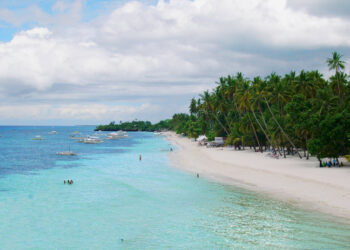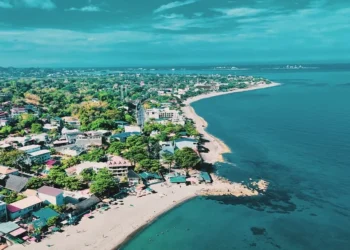Tamil Nadu, in South India, is home to over 400,000 Hindu temples, built by the famous dynasties like the Cholas, Pallavas, and Nayaks. They’re are known for their Dravidian-style architecture, long history, and devotion of countless Hindu devotees. This blog lists the 10 extremely famous temples in the state of Tamil Nadu.
1. Annamalaiyar Temple, Tiruvannamalai
The Annamalaiyar Temple in Tiruvannamalai constructed in the 9th century and dedicated to Lord Shiva, is represented as the fire element in the Pancha Bhoota Sthalams, five Shiva temples tied to natural elements. The temple is by Arunachala Hill, considered as the Kailasha of the south and linked to the great sage, Ramana Maharshi, who lived there. The temple has four gateways with Shiva story carvings, yards and small shrines. At Karthigai Deepam festival, they light a big fire on the hill for Shiva.
2. Brihadeeswarar Temple, Thanjavur
The Brihadeeswarar Temple in Thanjavur was built in the 11th century by Chola king Rajaraja I for Lord Shiva. It’s granite and one of India’s biggest temples, listed by UNESCO. The tower is 216 feet with an 80-ton stone on top. Walls have carvings of dancers and gods, showing exquisite Chola work. It’s made to make chants louder and is a part of Great Living Chola Temples, big for history and worship by the devotees.
3. Sri Ranganathaswamy Temple, Srirangam
The Sri Ranganathaswamy Temple in Srirangam is on an island in the Cauvery River for Lord Vishnu, called Ranganatha. The temple was constructed in 100 BCE, one of the oldest temples, and the biggest Hindu temple still in worship. Cholas added to it, with 21 towers, the tallest 240 feet. The temple complex has 108 god statues and gives food to visitors daily after offering the deities. Vaikuntha Ekadasi festival brings people to pray. Its seven walls and setup make it a top Vishnav temple.
4. Ramanathaswamy Temple, Rameswaram
The Ramanathaswamy Temple on Pamban Island was built in the 12th century, one of 12 Shiva shrines and a pilgrimage stop. Stories say Lord Rama prayed here after defeating Ravana. Its hallway is 1,200 meters, longest in the world, with carved pillars. It has 22 water tanks; Agni Theertham is for rituals. Deities and mustical beings carvings reflect the Dravidian style of the temple.
5. Kapaleeshwarar Temple, Chennai
The Kapaleeshwarar Temple in Chennai, in Mylapore, was built in the 7th century by Pallava kings, and reconstructed again in the 16th century. The temple is dedicated to Lord Shiva, specifically to one of his forms, Kapaleeshwarar, and Parvati, called Karpagambal. The gateway of the temple has carvings of Hindu stories, like Shiva dancing. In March, the Arubathimoovar festival has procession for 63 Shiva saints.
6. Thillai Nataraja Temple, Chidambaram
The Thillai Nataraja Temple in Chidambaram, from the 10th century, is for Lord Shiva as Nataraja, the cosmic dancer. The temple is represented as the air element in the Pancha Bhoota Sthalams, five Shiva temples tied to natural elements. The place is 40 acres with carvings of 108 dance moves from Bharatanatyam. It has both Lord Shiva and Sri Vishnu, which is rare. Natyanjali Dance Festival at Maha Shivaratri brings various classical dancers who worship the deities through dance.
7. Ekambareswarar Temple, Kanchipuram
The Ekambareswarar Temple in Kanchipuram, built in the 7th century by Pallavas, is for Lord Shiva, representing earth in the Pancha Bhoota Sthalams. A 3,500-year-old mango tree in the yard grows four mango kinds, significant to devotees. The temple has a 1,000-pillar hallway and a gopuram with carvings. Panguni Uthiram festival has parades and prayers.
8. Kumari Amman Temple, Kanyakumari
The Kumari Amman Temple in Kanyakumari, founded in the 8th century by the Pandyas and renovated by the Cholas, is dedicated to Goddess Devi Kanya Kumari, a form of Parvati. It’s one of 51 Shakti peethas(goddess sites). Located at a place where three seas meet—Arabian Sea, Bay of Bengal, Indian Ocean, the temple features a blue goddess statue. A rock nearby, tied to Swami Vivekananda’s meditation, adds more depth.
9. Thiruchendur Murugan Temple
The Thiruchendur Murugan Temple, by the sea, is one of six abodes of Lord Murugan, Shiva’s son. Built by the Cholas, it marks Murugan’s victory over a demon. Its large gopurams reflect the Dravidian style standing out in it’s oceanfront setting. Skanda Sashti festival depicts Murugan’s victory through rituals and procession. It’s one of the largest temple complexes of India.
10. Jambukeswarar Temple, Thiruvanaikaval
The Jambukeswarar Temple in Thiruvanaikaval, near Srirangam, dates to the 2nd century CE, and was expanded by Cholas. Dedicated to Lord Shiva as Appu Lingam, representing water in the Pancha Bhoota Sthalams, it features an underground stream that keeps the lingam wet. It has five gopurams, and carved pillars reflect the prominent Dravidian style. Panguni festival includes rituals worshipping Lord Shiva and Parvati prayers. The river nearby and water link make it a big pilgrimage spot.
Practical Tips for Visiting
Tamil Nadu’s hot, gets 60-80 inches rain a year. November to March is better, as it falls down to 70 to 85°F. Mornings are less busy, cooler. Bring water, sunscreen, hat for your travel. Rain jacket if you visit from June to September. Wear clothes covering shoulders, knees; take off shoes. Wash feet at tanks if told. No photos in the temple sanctum usually—ask priests. Quiet during prayers, don’t touch statues, and carvings unnecessarily. Festivals like Karthigai Deepam, Skanda Sashti get full, so plan ahead.
Conclusion
Tamil Nadu’s temples, from Annamalaiyar in Tiruvannamalai to Jambukeswarar in Thiruvanaikaval, hold serious history of the Sanatana Dharma or Hinduism and the link to the gods and their worship through rituals and prayers as a daily activity of the general populace. Built by old dynasties, they flaunt the unmatched craftmanship, constructions, carvings, and prayers that shape Tamil ways. These ten famous temples, in cities and by the sea, show the state’s strong Hindu faith and unmatched past.











